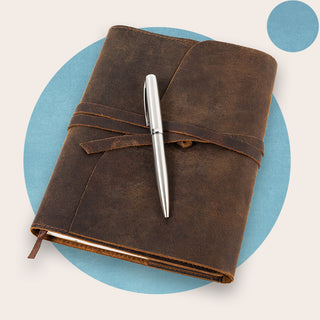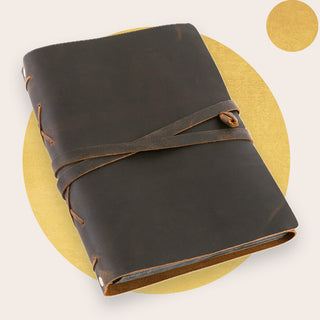Are you looking to get started with sketchbook journaling but know not where to turn? Are you an avid artist but have no idea how to get started chronicling your development?
Then step forth as we explore 3 steps for getting started as well as 3 reasons why this is a great thing for you and your artistic development.

1. Finding the Right Sketchbook
You are not going to get anywhere with sketchbook journaling if you do not go forth with the right sketchbook journal.
One of the most important things to consider is the weight and quality of the paper. You are looking to use thicker paper rather than thin, else it might struggle to cater to watercolors and other artistic endeavors. Thus, you do not want to use paper with a weight of under 70 lbs.
Secondly, consider the size of the journal that you are purchasing and think about what will work best for your own artistic vision. Some of you might be more inclined towards larger-scale projects, so a larger sketchbook will be necessary. The same is true for those looking to explore the small and microcosmic. Hopefully, your local art supplies shop will be able to cater to both sides of this illustrious coin.
2. Deciding a Page Theme
You can, of course, go forth without a theme, though if this is your first rodeo, then you might find it a little easier if you have a particular theme in mind when you take your first steps. If you are stuck for a theme but don't want to go on without one, try this handy list of tips to get started.
One of the most important things when building up a sketchbook page in a journal is not to rush it. This is not meant to be a quick activity, especially if this is an exercise in fusing illustrated journaling and mixed media. Thus, if you need some time away from it to focus on other things or even if you are just not feeling like it anymore, that is absolutely fine and you should honor that feeling as much as possible.
3. Add More Stuff
Illustrated journals and sketchbook pages are only finished when you are satisfied - if you are unsure and don't feel a sense of completion, then it likely isn't done, though this is not to say that it ever has to be done. A blank book might, after all, be your own artistic statement to the world, practicing a philosophy of minimalism and reductionism that would make even Eastern thinkers queasy.
You can make a sketchbook journal as minimal or maximal as you like - you are absolutely free to use whatever materials you like, ranging from a ballpoint pen to tar from your own lungs, and then some more! Heck, if you are the freak of the family and want to collect samples of your family members' blood in your sketchbook for some bizarre and legally-nebulous pagan ritual, then so be it.
Your own artistic impression on the world might be to sellotape a bunch of travel journals together and bind them inside a sketchbook.

Why Keep a Sketchbook Journal?
Since we have looked at how to keep a sketchbook journal, it seems only fair that we explore why you would even bother keeping one in the first place, right?
1. Creative Confidence
A creative journal is a forum within which you can freely experiment with new ideas, free from prying eyes and the pressure to create a wholly complete piece of art. But, of course, if you feel yourself particularly attracted to something that you have made in your sketchbook journal, you can always tear it out and give it a new home before the eyes of the art-hungry.
Even if you have no intention of showing anyone the results of your creative sojourns in your sketchbook journal, it is still an amazing way to flex your creative muscles and collage together the various aspects of yourself that might otherwise rub each other up the wrong way on canvas.
Many find such a journal to be an amazing way to express themselves and explore their tastes through mixed media, so tape or paste in just about anything that takes your fancy. Heck, this can even be a great way to learn just what you like, exploring the boundaries of your tastes.
2. Organization
If you are the kind of person that is likely to hold on to scrap pieces of paper - i.e. business cards, notes, receipts, gift tags, etc - then this kind of journal can provide an ample home for them that won't clutter your domestic space.
Trying to find a place for those old ticket stubs can be tricky, especially one that prizes them as something worth keeping and doesn't just locate them in the trash can. And, since this is your journal, you can also experiment by, say, drawing over and around these various scraps and bits of detritus that would otherwise be polluting your pockets.
Housing scraps in this way allows you to preserve these seemingly disconnected barbs of detritus in one place, strengthening them in their number to allow for the exploration of something else entirely.
If you are going to follow through with such an enterprise, then try using archival glue so that the scraps do not disintegrate over time. Indeed, just as books can mold and sprout mushrooms (which, when consumed, inebriate the consumer and send them into a psychedelic hellscape) these scraps of cultural detritus can disintegrate, especially with repeated use.
3. Memory
As cultural memory grows gradually weaker and more reliant on instant gratification via technological means, it becomes more necessary for mediums like sketchbooks to really seal on paper what our minds are loathe to remember so easily as they once did.
The more optimistic way to say this is that our brains are always absorbing new information and thus making room for new information by parping out the old. In this way, memories have been known to fade, though such an inherent action can be combatted with sketchbook journaling.
For those looking to somehow remember everything, colors, images, and paper scraps can be a vital and more accurate representation of your thoughts and feelings than the fading and unreliable daguerreotypes of a photo album.

Final Words
So, there you have it! Hopefully, you have found a way to go forth in your own way.
FAQs Sketchbook Journaling
CAN A SKETCHBOOK BE USED AS A JOURNAL?
In some senses, yes, though this does kind of defeat the point of it being a sketchbook. The clue is, after all in the name - this is a book for sketches. Sure enough, there is plenty of writing in art (see Jean Michel Basquiat), but the idea of a journal is somewhat at odds with a sketchbook.
WHAT IS THE DIFFERENCE BETWEEN A SKETCHBOOK AND A JOURNAL?
The clue is very much in the name. A sketchbook is, of course, a book for sketching. Sure, there are plenty of journals that feature art and this is something that should continue to be encouraged, for it is in the mixing of media that new things are born. With journaling, there is more often a tendency towards writing, whereas a sketchbook is more focused on art, though these two things blend considerably.
WHAT IS THE DIFFERENCE BETWEEN A SKETCHBOOK AND A VISUAL ART DIARY?
The term visual art diary implies that it is meant to be communicated with on at least a semi-regular basis, whereas the dedication to a sketchbook journal is likely to be more relaxed.



